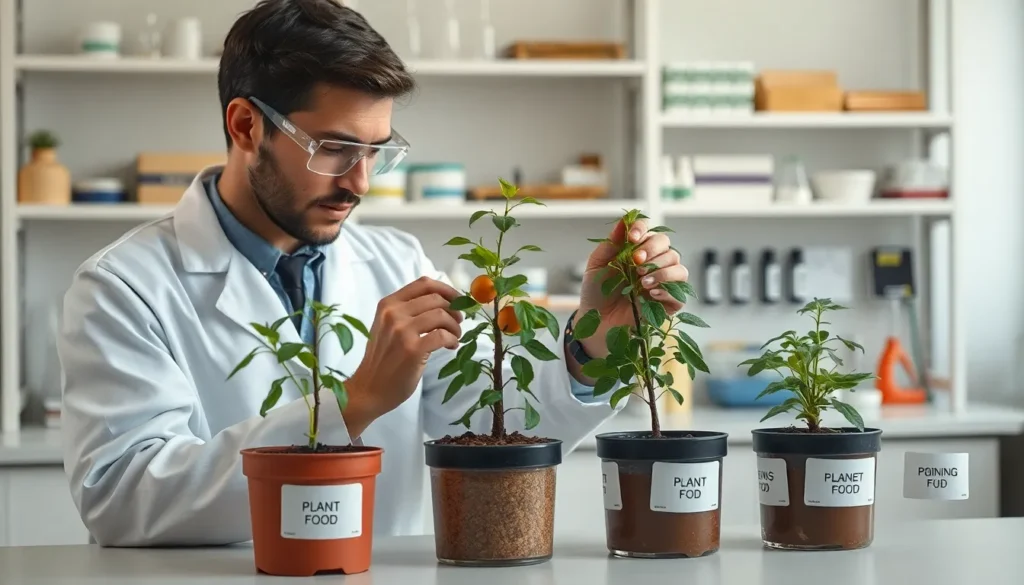Table of Contents
ToggleUnderstanding independent and dependent variables can feel like deciphering a secret code, but it doesn’t have to be a daunting task. Imagine you’re a scientist in a lab, trying to figure out if your new plant food actually makes your houseplants grow taller. The independent variable is the plant food you’re using, while the dependent variable is the height of those eager green friends. Simple, right?
Understanding Variables
Variables play crucial roles in scientific experiments, affecting outcomes and demonstrating relationships. Clarifying independent and dependent variables aids in understanding experimental design.
What Are Independent Variables?
Independent variables stand alone and influence the dependent variables. Researchers alter these variables to assess their effects. In the plant food experiment, the type of plant food serves as the independent variable. Different formulations, like organic versus synthetic options, exemplify variations in independent variables. By manipulating these, scientists gauge effects on the plants’ growth. An example would involve testing three distinct plant foods to observe which leads to greater plant height.
What Are Dependent Variables?
Dependent variables depend on independent variables and measure the outcomes of experiments. In the same plant food study, the height of the plants represents the dependent variable. It changes in response to the type of plant food used. Researchers may quantify height using precise measurements, such as inches or centimeters, at defined intervals. For instance, if the study monitors growth over four weeks, plant heights at the end of each week showcase how the dependent variable fluctuates based on the independent variable.
Independent Vs Dependent Variable Examples

Independent and dependent variables play crucial roles in experiments and everyday situations. Understanding these examples clarifies their significance in measuring outcomes and drawing conclusions.
Scientific Research Examples
In scientific studies, independent variables often include elements researchers manipulate. For instance, in a drug efficacy trial, the independent variable is the dosage of medication administered. The dependent variable measures the patient’s response, such as symptom improvement rates. Another example involves educational research, where different teaching methods serve as independent variables. Test scores, which indicate student performance, act as the dependent variable. By altering the teaching methods, researchers observe variations in students’ scores, highlighting the relationship between the independent and dependent variables.
Real-World Applications
Independent and dependent variables appear in various real-world situations, including marketing research. Companies might change advertising budgets as the independent variable. Sales figures become the dependent variable, reflecting how budget alterations impact revenue. In agriculture, planting methods can serve as independent variables; crop yields act as dependent variables. Farmers can adjust planting techniques, observing how the yields respond to those changes. Such practical applications illustrate the relevance of understanding independent and dependent variables in decision-making processes.
Importance of Identifying Variables
Identifying variables plays a crucial role in research and experimentation. Researchers can clarify relationships between factors by distinguishing between independent and dependent variables.
Impact on Hypothesis Testing
Hypothesis testing relies heavily on the identification of variables. By defining these variables clearly, researchers can formulate testable hypotheses that specify expected outcomes. Independent variables serve as the inputs that researchers manipulate, while dependent variables represent the results being measured. In drug trials, for instance, the medication dosage is an independent variable, and the patient’s response is the dependent variable being observed. Clear definitions streamline the analysis and interpretation of results. Well-identified variables enhance the accuracy of conclusions drawn from experiments.
Role in Experimental Design
Experimental design fundamentally centers around independent and dependent variables. Researchers structure their studies by pinpointing which factors to test and how to measure outcomes. The independent variable often influences the dependent variable, allowing scientists to investigate cause-and-effect relationships. A well-designed experiment controls for external variables to ensure that changes in the dependent variable occur only due to the manipulation of the independent variable. In marketing studies, for example, adjusting advertising budgets as the independent variable enables measurement of their impact on sales figures as the dependent variable. This structured approach provides clarity and validity to the research findings.
Common Mistakes in Variable Identification
Identifying variables in research isn’t always straightforward. Several common mistakes can lead to confusion and misinterpretation of data.
Confusing Independent and Dependent Variables
Researchers often confuse independent and dependent variables. Independent variables stand alone, influencing changes in dependent variables. For instance, in an experiment involving different doses of medication, the dosage is independent, while the patient’s response is the dependent variable. A mistake occurs when someone mislabels these roles, which can skew the research’s findings. Clear differentiation is crucial for accurate data interpretation and valid conclusions.
Misinterpretation of Results
Misinterpreting results can arise from incorrect variable identification. When independent variables are mixed up with dependent variables, the conclusions drawn may be flawed. For example, if someone believes the dependent variable affects the independent variable, they might incorrectly suggest that patient recovery speeds dictate medication dosages rather than the other way around. Such misunderstandings lead to erroneous interpretations and potentially impact future studies. Thus, clear understanding and appropriate labeling of variables significantly enhance research integrity.
Grasping the distinction between independent and dependent variables is vital for anyone engaged in research or experimentation. Recognizing how these variables interact allows for more accurate data interpretation and enhances the overall quality of studies. By clearly defining these roles researchers can establish reliable cause-and-effect relationships. This understanding not only strengthens scientific inquiry but also applies to everyday decision-making. As readers explore various contexts where these variables play a role they’ll become better equipped to analyze information critically. Ultimately a solid grasp of independent and dependent variables lays the foundation for successful research and informed conclusions.







